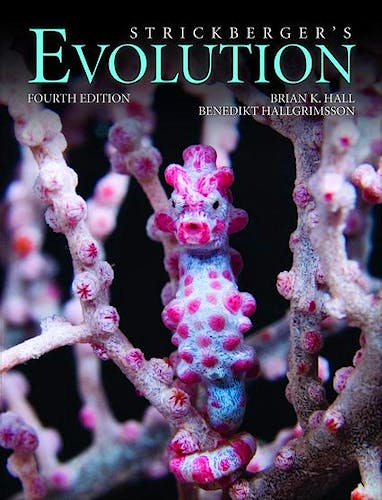

No hay productos en el carrito



Strickberger's Evolution
Hall, B. — Hallgrímsson, B.
4ª Edición Diciembre 2007
Inglés
Tapa dura
762 pags
2200 gr
22 x 28 x 4 cm
ISBN 9780763700669
Editorial JONES AND BARTLETT
LIBRO IMPRESO
-5%
54,80 €52,06 €IVA incluido
52,69 €50,06 €IVA no incluido
Recíbelo en un plazo de
2 - 3 semanas
OVERVIEW
Thoroughly updated and reorganized, Strickberger's Evolution, Fourth Edition, presents an overview of prevailing evidence and theories about evolution by discussing how the world and its organisms arose and changed over time. Remaining consistent with Strickberger's engaging writing style and awareness of the history of the study of evolution, the authors carefully unfold: (i) The evidence for evolution as a science, (ii) The enormity of time, including cosmological and geological evolution and its impact on life; (iii) The origin of life on Earth; (iv) The diversity, relationships and evolution of organisms; (v) How genes, cells, and embryonic development provide the organic framework by which evolution occurs; (vi) How populations may remain stable for long periods of time or give rise to new species; (vii) How evolution and society (including religion) impact one another. Throughout, the emphasis is on analysis of the evidence for the fact of evolution and the theories explaining evolution at all levels from molecules to populations.
APPROPRIATE COURSES
Suitable for a first undergraduate class in evolution, for a class on how organismal diversity arose and is maintained, for an introductory biology class using evolution as the guiding principle, or for a senior undergraduate class that seeks to synthesize a program of study using evolution as the framework.
KEY FEATURES
· Each chapter has been reviewed by one or more individuals expert in
the topic covered in the chapter.
· Summaries have been moved to the beginning of each section to provide
an overview of the material before reading in-depth discussions.
· Boxes emphasize information with wide application - for example "What
is a gene?" How many kingdoms of life are there?" "What are the
links between genotypes and phenotypes?"
· Interviews with active researchers demonstrate the rapid progression
being made within evolution.
· Bulleted lists highlight key points while important concepts are emphasized
in the text, allowing for rapid comprehension and revision of a chapter.
· Incorporates a strong emphasis on the relationship between evolution
and development/embryology.
· Footnotes are used to provide up-to-date references to original studies.
The cited references are gathered in a single list at the end of the text.
TABLE OF CONTENTS
Part I. The Historical Framework: Evolution as Science
1. Before Darwin
2. Darwin and Natural Selection
3. The Arguments and the Evidence for Evolution
Part II. Origins: The Enormity of Time
4. The Origins of Cosmic Structures and Chemical Elements
5. The Origin of Earth
6. Molecules, Protocells, and Natural Selection
7. From Molecules to Life
8. Origins of Cells and the First Organisms
Part III. The Organic Framework: Genes Cells and Development
9. Cell Division, Mendelian Genetics and Sex Determination
10. Chromosomes, Mutation, Gene Regulation and Variation
11. Species, Phylogeny and Classification
12. Genes and Phylogenetic Relationship
13. Genes, Development, and Evolution
Part IV. The Organisms: The Diversity of Life
14. Evolution of Plants and Fungi
15. Animals and their Origins
16. Evolution Among the Invertebrates
17. Chordate and Vertebrate Origins
18. From Water to Land to Air: Amphibians and Amniotes
19. Evolution of Mammals
20. Primate Evolution and Human Origins
Part V. Populations and Speciation: Changes Within and Between Species
21. Populations, Gene Frequencies, and Equilibrium
22. Changes in Gene Frequencies
23. Structure and Maintenance of Populations
24. From Populations to Species
Part VI. Evolution and Society: Past, Present, and Future; Society and Religion
25. Cultural and Human-Directed Evolution
26. The Impact of Darwin's Theory on Religion
ABOUT THE AUTHORS
Brian K. Hall - Dalhousie University
Brian Hall, born, raised and educated in Australia, has been associated with Dalhousie University in Halifax, Nova Scotia since 1968, most recently as a University Research Professor and George S. Campbell Professor of Biology, and since July 2007 as University Research Professor Emeritus. He was Killam Research Professor at Dalhousie University (1990-1995), Faculty of Science Killam Professor (1996-2001) and Canada Council for the Arts Killam Research Fellow (2003-2005).
Trained as an experimental embryologist, for the past 40 years he has undertaken research into vertebrate skeletal development and evolution and played a major role in integrating evolutionary and developmental biology into the discipline now known as Evolutionary Developmental Biology (evo-devo); he wrote the first evo-devo text book , published in 1990 and a second edition in 1999 (Hall 1999a).
A fellow of the Royal Society of Canada and Foreign Honorary Member of the American Academy of Arts and Sciences, Dr. Hall has earned numerous awards for his research, teaching and writing, including the 2005 Killam Prize in Natural Sciences, one of the top scientific awards in Canada.
Benedikt Hallgrímsson - University of Calgary
Benedikt Hallgrímsson was born in Reykjavik, Iceland, and completed his studies at the University of Alberta and the University of Chicago. A biological anthropologist and evolutionary biologist, he combines developmental genetics and bioinformatics with morphometrics to address the developmental basis and evolutionary significance of phenotypic variation and variability. His work has focused on humans and other primates and comparative approaches to study the evolutionary developmental biology of variation. He is the editor-in-chief of Evolutionary Biology, a journal dedicated to the synthesis of ideas in evolutionary biology and related disciplines.
Based at the University of Calgary, Dr. Hallgrímsson teaches organismal biology and anatomy. There he has received several Gold Star Teaching Awards, a Letter of Excellence Lecturer Award and the McLeod Distinguished Achievement Award. He is featured on the University of Calgary "Great Teachers" website. From the American Association of Anatomists he received the Basmajian/Williams and Wilkins Award for educational contributions in 2001.
© 2025 Axón Librería S.L.
2.149.0